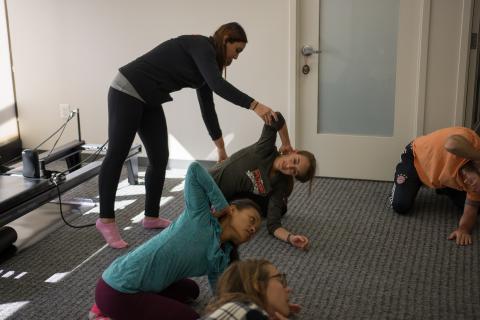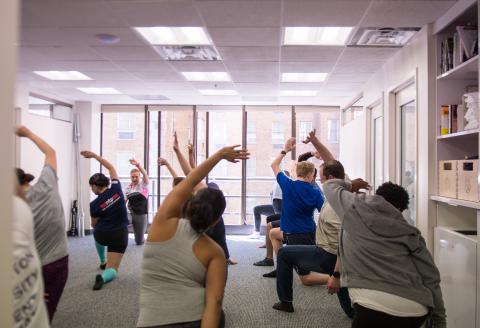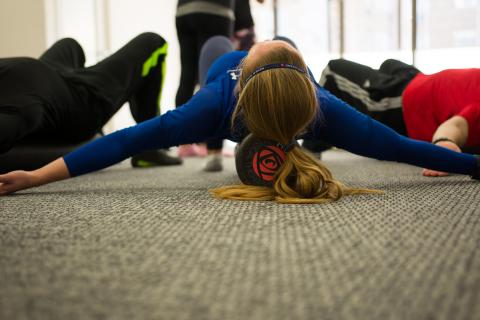One hotly debated issue in physical therapy is whether a dynamic or a static stretching routine is better for performance and recovery. The simple answer: both!
Both dynamic and static stretching used in combination have benefits for improving mobility, increasing flexibility and decreasing risk of injury. The key is knowing the components of each stretching method and when to use them.

A Rose therapist helps a client with her stretch during a workshop at the downtown Washington, DC location near Farragut Square.
Dynamic stretching
Dynamic stretching uses active muscular movements and momentum to take joints and muscles through their full range of motion. Unlike static stretching, dynamic stretching does not require a position to be held at end-range. For example, when swimmers swing their arms around to loosen their shoulders but do not hold a position, they are engaged in dynamic stretching.
"Dynamic stretching is ideal prior to exercise and activity..."
Dynamic stretching is ideal prior to exercise and activity in order to prepare joints for movement and muscles for activation. Physically, dynamic stretching pre-workout increases your core temperature and brings increased blood flow to working muscles. It “warms up” muscles prior to activity while keeping muscle fibers in the ideal position for optimal contraction. Mentally, dynamic stretching prepares your mind for the movements you are about to engage in and provides stimulation to the central nervous system. There are numerous dynamic stretching activities one can perform, but the most effective are those that are activity or sport specific and incorporate linear, lateral, and rotational movements.

Rose Physical Therapy leads workshops on stretching efficiently and effectively at both our downtown Washington, DC adjacent to Dupont and Logan Circle and Farragut Square, or at our Capitol Riverfront location adjacent to the Navy Yard and Nationals Baseball park.
Static stretching
"Static stretching is what we most often consider when we think about stretching."
Static stretching is what we most often consider when we think about stretching. Static stretching brings a muscle to its end-range and holds the position for a prolonged time in order to improve tissue flexibility. Unlike dynamic stretching, where muscles are asked to contract and activate, static stretching allows muscles to be in a relaxed state. The goal of static stretching is to increase elongate muscle fibers and over time adapt to a new tissue length. Research suggests that holding the position for 30–60 seconds will help to increase flexibility in the targeted tissue. Performing these stretching post-workout is key to achieve gains in joint range of motion and improve muscle length.

Stretching on a foam roller can be helpful. No foam roller? You can just use a rolled up towel in the same orientation shown above.
Putting it together
Incorporating both static and dynamic stretching into your daily exercises can provide benefits for overall mobility and flexibility and can be used in conjunction to optimize performance. Check out rose PT’s YouTube channel for examples of stretches for athletes.

A Rose therapist leads a stretching session for an air guitar competition at the Wonderland Ballroom in Washington, DC. Everybody needs to stretch!


